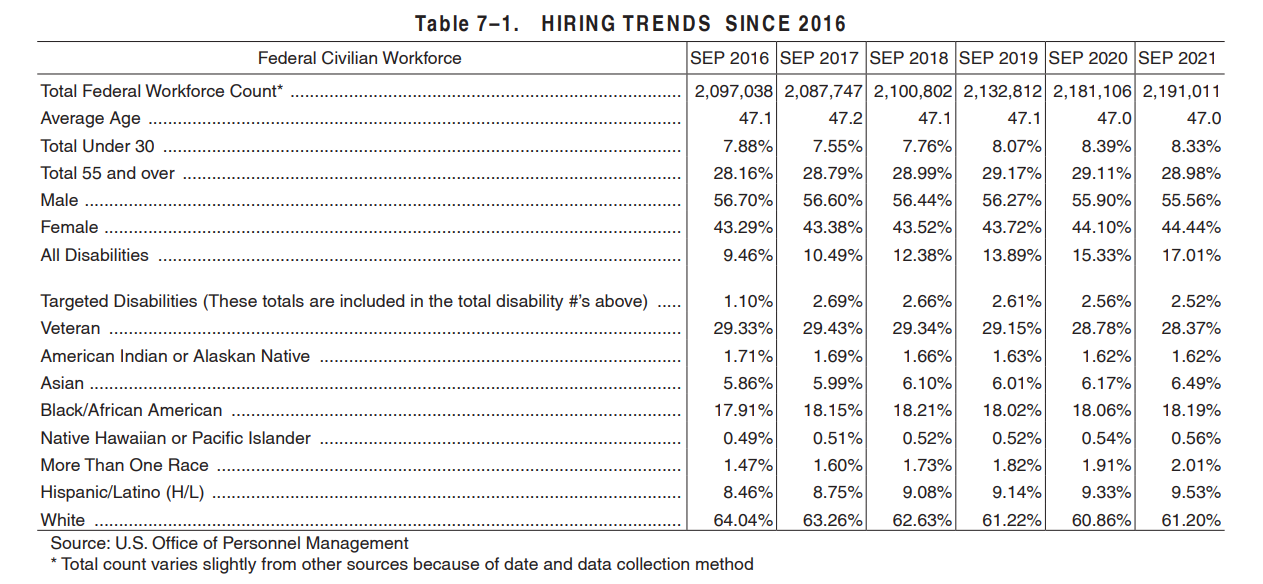For feds, White House 2023 budget request is more than just the 4.6% pay raise
The administration is asking Congress for $1.58 trillion for defense and non-defense discretionary accounts, $70 billion more than fiscal 2022 enacted appropria...
The White House’s fiscal 2023 budget request sent to Congress today seeks across-the-board increases in discretionary spending for almost every agency.
The administration is asking Congress for $1.58 trillion for defense and non-defense discretionary accounts, $70 billion more than fiscal 2022 enacted appropriations.
But the real message in this annual exercise isn’t the funding request, which observers often say is dead on arrival on Capitol Hill. The Biden administration is continuing the long-term effort to rebuild, reskill and revamp the federal workforce.
“The federal government can only realize its vision of being a model employer by continuously evaluating and improving how its workforce is supported and engaged,” the White House wrote in the Analytical Perspectives section of the budget request. “It starts with offering the administration’s unwavering support for the federal workforce by treating them with dignity and respect, and providing them with resources they need to carry out their mission.”
To start off, the White House is proposing a 4.6% pay increase for federal civilian employees and military service members. Federal News Network first reported the proposed pay increase in February.
“Between 2009 and 2020, U.S. average worker pay rose by 38% while federal civilian pay increases amounted to only a 15% rise,” the budget states. “The differential between federal civilian pay and private sector pay expanded substantially over this period, creating meaningful attrition risk within the existing workforce, reducing the competitiveness of federal jobs, and devaluing the contributions of the federal workforce to the nation. The proposed federal pay increase is needed to prevent federal pay from falling even further behind.”
Addressing systemic challenges
But the changes go beyond just a pay increase. The administration is building on its efforts in 2021 to change systemic federal workforce challenges from hiring to pay to support structures and processes.
“To compete [with the private sector], the federal government must move quickly to design, test and adopt approaches that will build diverse federal talent pipelines and engage and retain that talent once hired, while simultaneously strengthening protections that preserve the nonpartisan, merit-based civil service that is a hallmark of American democracy. The federal government’s rules, processes and institutional norms must support agencies as they evolve how they work, making the federal government more efficient, resilient and effective,” the administration states. “A sizeable percentage of the federal workforce is eligible to retire today (15%) and in the next five years (30%). Replacing the valuable contributions and skillsets of retiring public servants will be a challenge, given the competitive U.S. labor market. Coupled with longstanding, additional challenges stemming from a fragmented hiring process—challenges that have become further complicated and cumbersome for applicants and agencies alike—agencies face obstacles as they seek to recruit, hire, engage, and retain early career talent in particular in high-demand career fields, and in certain geographic areas.”
One way agencies will address the workforce challenges is by hiring 35,000 interns in 2023, which the administration said will be an increase over 2022 plans.
“The President’s Management Council has formed an internship working group that will lead and guide improvements to internship policies and procedures, including working with the Office of Personnel Management (OPM) to reduce barriers to hiring a diverse group of paid interns and bolster federal internship programs,” the budget states.
The administration also is bolstering the workforce through agency talent teams. The budget request would expand these teams, which the administration established in 2021 across most CFO Act agencies to improve hiring assessments and develop new tools to help improve hiring outcomes.
Additionally, the budget would provide funding for select agencies to share their high quality competitive hiring announcements with others.
“This will help decrease the number of public announcements without any selections and increase applicant placement, leading to an improved applicant experience and ensuring agency hiring managers can select the talent they need,” the document states. “To scale these best practices, OPM is building functionality to engage subject matter experts (SMEs) in technical assessments and leveraging centralized technology platforms to allow agencies to share approved applicant lists, so hiring managers can quickly see resumes of applicants who have been assessed and are ‘pre-cleared’ for immediate selection.”
Last year, the State Department and the Chief Data Officer’s Council were among the organization demonstrating the SME approach to hiring.
HR managers attrition rate is high
The administration recognizes that changes to the hiring process are helpful, but will go nowhere without a strong and skilled group of human resources employees and managers.
“Over the last five fiscal years, retention rates for HR management professionals have consistently trailed the governmentwide average retention rate (69.7% to 77.2%),” the document states.
The Office of Management and Budget set up a hiring assessment line of business in 2021. In the 2022 budget “passback” document, OMB told agencies to make sure they are spending money to ensure their human resources and hiring managers have the necessary tools and capabilities to bring on the talent necessary to meet all of these goals.
These and many other efforts come under the guise that the federal workforce hasn’t kept the pipeline of employees at all age ranges flowing.
“The federal workforce has an average age of 47 years. Almost 29% (635,016) of employees are older than 55, while 8.3% (182,472) of employees are younger than 30, an increase from 8.1% (compared to December 2020),” the budget states.
OMB said the age gap is widening specifically at the 24 large and mid-sized agencies since 2007. This is especially true for some hard-to-hire career fields like technology, where federal IT workers under 30 make up about 3.5% of the total workforce.

The administration also is addressing the return to the office challenges agencies face. It is encouraging leaders to remain flexible and agile as the hybrid workplace continues to evolve.
“Rather than providing a prescriptive set of new policies and rules that agencies must follow in determining future work arrangements, the administration is committed to encouraging innovation, creativity, experimentation, learning and evidence-building in different work environments,” the budget states. “By utilizing expanded flexibilities in work arrangements and increased adoption of technology similar to private sector strategies, the government will enhance its ability to recruit and retain top talent.”
Reinvigorate Federal Executive Boards
OMB said agencies should continue to pay attention to long-term trends that will open the door for continued innovative approaches that balance mission needs with employees’ health and welfare needs.
Finally, the administration is changing the governance and funding structure of the Federal Executive Board (FEB) community. It wants to create a $10 million Line of Business and establish a FEB program management office to improve collaboration outside of the Washington, D.C. area.
“Centered around a coordinated set of workforce and administration priorities, FEBs will focus on local recruitment efforts helping to build the next generation of Federal talent from diverse communities. In particular, leveraging FEBs to build internal and external relationships that will fortify federal talent pipelines and recruitment is urgent given the challenges federal agencies face around federal hiring,” the documents state. “It is expected that this FEB reform effort will lead not only to a new governance structure in Washington, D.C., but also to enhanced practices in FEBs across the nation. A greater focus on pooling resources in areas of common interest will advance program efficiencies and cost savings and lead to better engagement opportunities for federal employees in the field enhancing overall agency mission resilience. For example, FEBs will have expanded resources and capabilities to support the federal workforce in engaging directly with their communities and serving as coordinated and targeted recruitment hubs that can connect federal agencies with regional talent pools, such as local educational institutions. Renewed FEBs will be able to assist in ensuring a more diverse workforce with representation from underserved communities and regions across the nation.”
Copyright © 2024 Federal News Network. All rights reserved. This website is not intended for users located within the European Economic Area.
Jason Miller is executive editor of Federal News Network and directs news coverage on the people, policy and programs of the federal government.
Follow @jmillerWFED







